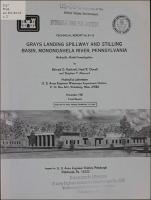Please use this identifier to cite or link to this item:
https://hdl.handle.net/11681/13466| Title: | Grays Landing Spillway and stilling basin, Monongahela River, Pennsylvania : hydraulic model investigation |
| Authors: | United States. Army. Corps of Engineers. Pittsburgh District Rothwell, Edward D. Oswalt, Noel R. Maynord, Stephen T. |
| Keywords: | Grays Landing Pennsylvania Monongahela River Spillways Stilling basins Hydraulic structures Hydraulic models |
| Publisher: | Hydraulics Laboratory (U.S.) Engineer Research and Development Center (U.S.) |
| Series/Report no.: | Technical report (U.S. Army Engineer Waterways Experiment Station) ; HL-81-13. |
| Description: | Technical Report Abstract: Tests were conducted on a 1:36-scale section model to investigate the hydraulic performance of the deeply submerged stilling basin for the Grays Landing Spillway. The model was used to evaluate and develop the most satisfactory stilling basin for optimum hydraulic performance. The purpose of the model investigation also included determining the pressures along the spillway crest, velocities in the stilling basin and exit channel, and the capability of various stilling basins to pass ice without impacting and abrading the apron, baffle piers, and end sill. The size, gradation, and extent of riprap required for adequate protection of the downstream channel were also determined. The hydraulic model investigation of the stilling basin revealed the general adequacy of the design of the spillway with satisfactory performance of the proposed spillway crest. From the hydraulic performance of various types of energy dissipaters investigated, the most appropriate stilling basin was the type 5 design. Shorter basins produced higher velocities downstream (up to 15.5 fps) and required larger downstream riprap protection. The type 5 design stilling basin allowed the baffle blocks to be located farther downstream to prevent the direct attack of ice against the baffles and stilling basin apron. The recommended type 5 stilling basin design is a conventional hydraulic-jump type energy dissipater which would perform well for both the initial construction of one lock, a 576-ft-wide spillway crest and stilling basin, and the ultimate construction of two locks, a 460-ft-wide spillway crest and stilling basin. The recommended downstream riprap protection, plan 2, consists of a 72-ft length of d𝟷𝟶𝟶 = 30-in. riprap with a maximum stone weight of 1350 lb, followed by a 108- ft length of d𝟷𝟶𝟶 = 18-in. riprap with a maximum stone weight of 292 lb. Pressures obtained for a range of flow conditions indicated that no serious negative pressures should be encountered on boundaries of the prototype. Additional analysis of model-data was conducted to develop a relationship between headwater, tailwater, and minimum pressures on the upstream quadrant of the spillway crest. For spillway designs subject to submerged flow conditions, the plot presented as Plate 12 herein should be used to select an appropriate design head so that the minimum pressure, considered sufficient to induce cavitation, will not be less than -20 ft. |
| Rights: | Approved for public release; distribution is unlimited. |
| URI: | http://hdl.handle.net/11681/13466 |
| Appears in Collections: | Technical Report |
Files in This Item:
| File | Description | Size | Format | |
|---|---|---|---|---|
| TR-HL-81-13.pdf | 6.26 MB | Adobe PDF |  View/Open |